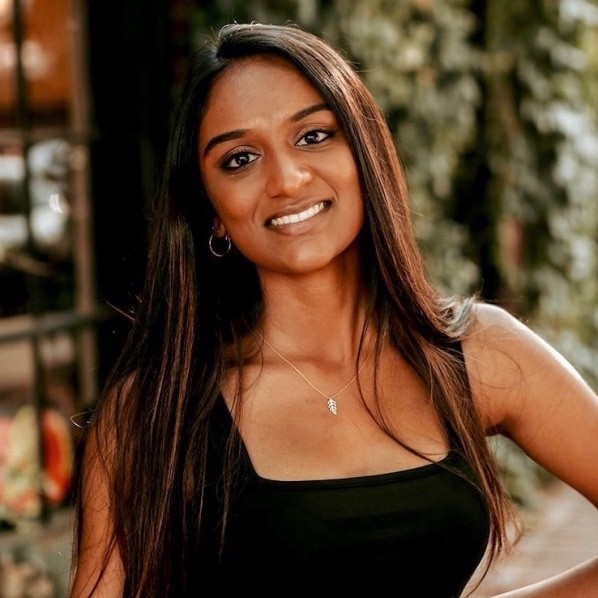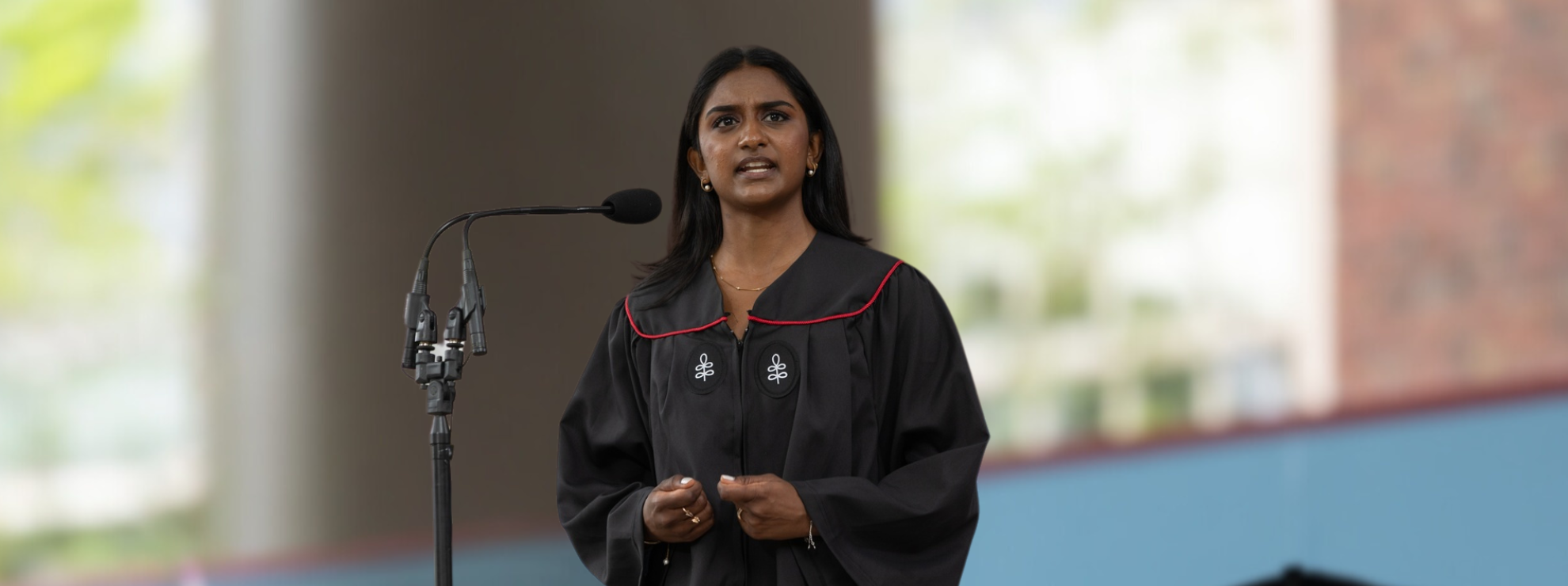(May 29, 2024) Halfway through her address at the Harvard Commencement 2024, Shruthi Kumar went off script. As the crowd roared its approval, she acknowledged 13 of her peers, who had not been allowed to attend the commencement ceremony due to the university’s stance on pro-Palestine protests. “As I stand here today, I must take a moment to recognize my peers – the 13 undergraduates in the Class of 2024 that will not graduate today,” Shruthi, a powerful orator, announced. “I am deeply disappointed by the intolerance for freedom of speech and the right to civil disobedience on campus.”
Nebraska-born Harvard graduate Shruthi Kumar has never been one to go unnoticed in a crowd. Growing up in Nebraska, she made the most of what the US’ social and educational fabric had to offer, and also stayed in touch with her Indian roots, learning classical dance and also yoga. “I grew up in the Great Plains of Nebraska alongside cattle ranches and cornfields,” Shruthi said in her commencement address, titled ‘The Power of Not Knowing’. “As the eldest daughter of South Asian immigrants, I was the first in my family to go to college here in the US. There was a lot I didn’t know,” the Global Indian said.

Shruthi Kumar was one of three students from the class of 2024 who had won the opportunity to deliver an address at the Harvard Commencement Ceremony
A star is born
However, there was a lot she did know – growing up, Shruthi was a versatile star student, making the most of the holistic and dynamic education system in the US. Apart from excelling academically, Shruthi plays the violin, has her own non profit and is a prize winning orator. “I just like learning new things about the world,” Shruthi said. “You’re constantly learning.” She was also one of the US’ top teen ‘yoga athletes’.
Always politically driven and inclined to public speaking, Shruthi Kumar was a finalist in the 2019 NSDA Original Oratory competition, and in that year, named the 2019-2020 Voice of Democracy winner. She’s also an experienced yogini, and was the first Indian-American to represent Team USA at the World Championship of Yoga Sports, and is the founder of yo-yogi.org, a non-profit dedicated to making student health and well-being a priority in schools worldwide. As if that isn’t enough, she has also won prizes for her neuroscience research and became a published author in 2017, when her poetry was appeared in that year’s edition of Creative Communication Celebration of Poets.
Shruthi began doing yoga as a child – “I just like how you have control over yourself. Yoga allows you to have control over your own body.” In the early days, her practice was meditative, but by the time she hit her teens, she was on the lookout for a new challenge. She began doing yoga competitively, and by the time she turned 16, she she was ranked in the top three in the US. In 2017, she went on to represent Team USA at the World Championship in China. “I was kind of shocked,” she said later. “Going in to this I didn’t expect to get any high rankings as I did.”
Mindfulness for mental health
However, not everything was rosy and being in high school is a challenging time, especially for immigrant kids in the US, where the pressure to overperform is very high and constant. So when her cousin was diagnosed with depression at the age of 13, Shruthi felt compelled to do something about it. While conversations around mental health are common enough in the US, the treatment options, which include therapy or medication are simply out of reach for most middle class homes, and certainly not for low-income, marginalised communities. However, mental health is a pressing problem, with research showing that 49 percent of students in the Washington DC area report feeling “a great deal of stress on a daily basis.” Around 26% of the respondents had been diagnosed with depression.


In fact, life was hectic for Shruthi herself. “I had to go to bed at 4 am just to finish homework,” she recalled. Realising this helped spark the idea for yo-yogi. That year, before she began her sophomore year, she took a spiritual trip to India,. and spent two weeks in the mountains. Her aim was to explore yoga, which, in the west, is often seen as just another physical activity. It gave her confidence and Shruthi learned thorugh experience that five minutes of focussed meditation have the power to change your day.
Since post facto care often requires medical intervention and is also expensive, Shruthi decided to take a preventive approach for which she leaned into her years of experience practicing yoga and meditation. Her focus was on young minds, as their brains are still developing and more open to absorbing new things. She began teaching techniques like mindfulness and meditation, to help students cope with the stress of life in a more holistic fashion. According to research by Harvard Medical School, yoga practice in schools leads to increased productivity, focus and concentration, improves self regulation, reduces anxiety and stress and leads to better academic performance overall.
Go-Yogi
Her organisation, Go Yogi, uses technology to integrate custom stress management techniques, breathing exercises and mindfulness practices directly into school curriculums. The go-yogi app has over 2000 student users, is part of the curriculum in several states and also has over 40 multilingual lessons in mindfulness. They also focus on the mental wellbeing of teachers.
Even in high school, Shruthi was seen as a generous person, who cared for the welfare of other people. She volunteered weekly at the local hospital, and taught yoga to kindergarten students. “Volunteering is important to me because sometimes I take my life for granted, and it’s a good reminder every week to go and help someone who really needs it,” she said.
Outside of school, she was an active member of the NSAA Student Advisory Committee, a student-run group that helps young people get involved in extracurriculars. At the time, she was interested in law and medicine and eventually hoped to study medicine at Harvard.


Shruthi Kumar entered Harvard University as a pre-med student before switching tracks to public health.
Life at Harvard
As Shruthi Kumar described in her speech, life at Harvard University was very much marked by embracing uncertainty, and the “power of not knowing. “The words ‘I don’t know’ used to make me feel powerless,” she admitted in her speech. “Like there was no answer, and therefore, no way. As if I was admitting defeat.” That would change on campus.
Shruthi arrived at Harvard as a pre-med student, and boldly decided to follow her passion and switch her major to the humanities. “I didn’t know a field called the ‘History of Science’ even existed. I now find myself a graduate of the Department,” she said. “In my freshman year of college, for the first time in my life, I was taught by a professor of colour. A Historian of Science who made clear to me that history is just as much about the stories we don’t know as the stories we do.”
The Menstruation Equity Project
She continued her activism too. In 2021, during her sophomore year, she realised she had her period. However, when she checked the women’s restroom at the Science Center, she found the dispenser was empty. It made her think. “Why is this installed here, if it’s not going to be restocked – if it’s not supporting me. And what do I do now?” Her options were to walk across campus to a pharmacy, or back to her dorm and either way meant being late for class. She wondered how many women had to interrupt their education for the same reason.
“It led me to think about ideas of infrastructural equity and what it means for women to be in educational spaces,” Shruthi said. And when she did her research, she found that over one-third of women have missed events or activities due to a lack of access to menstrual products. As the founder of the Menstrual Equity Project, she led efforts to make Harvard 100% period secure by ensuring free and accessible menstrual products across campus. This project involved extensive collaboration with university administration and custodial teams, resulting in the installation of menstrual product dispensers in over 817 bathrooms across campus.
Kumar was also a vocal advocate for affirmative action, organizing protests and speaking out against efforts to end race-conscious admissions policies at Harvard. She highlighted the importance of diversity and the potential negative impacts on campus culture and student life if affirmative action were dismantled.
Kumar’s diverse contributions, from menstrual equity to racial diversity advocacy, free speech and mental wellbeing, underscore her commitment to social justice and equity. From her beginnings in Nebraska to her impactful years at Harvard, her experiences blend cultural richness with a drive for social change. Advocating for marginalized communities, she stands as a powerful voice for inclusivity and empowerment, leaving a lasting impact on those around her.
Follow Shruthi Kumar on LinkedIn





